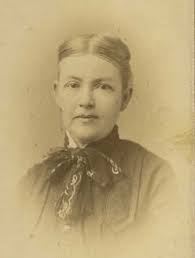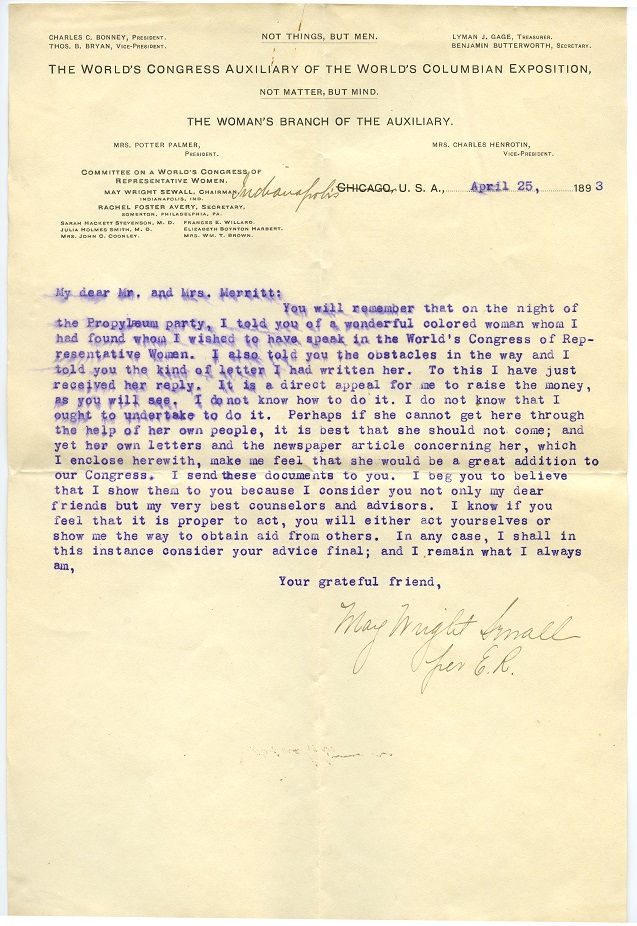
Hoosier Women and the Suffrage Movement
The women's suffrage movement touched all corners of the United States and Indiana was no
exception. Hoosier women were involved from its beginning. In 1851, just three years after Seneca
Falls, women in Dublin, Indiana formed the Indiana Woman’s Rights Association and in 1859,
Hoosier suffragists submitted the first women’s suffrage petition to the Indiana Legislature.
Over the next several decades, Hoosier women organized. They formed local and statewide
suffrage groups, submitted petitions to the state legislature for equal suffrage, lobbied state and
federal politicians for support, and held parades and protests in an attempt to gain suffrage.
In 1917, they almost succeeded. The Indiana General Assembly passed three laws, including
amending the state constitution to allow women’s suffrage and granting Hoosier women the right
to vote in certain elections. However, anti-suffragists successfully challenged these laws and the
legislature declared the partial suffrage granted to women unconstitutional.
exception. Hoosier women were involved from its beginning. In 1851, just three years after Seneca
Falls, women in Dublin, Indiana formed the Indiana Woman’s Rights Association and in 1859,
Hoosier suffragists submitted the first women’s suffrage petition to the Indiana Legislature.
Over the next several decades, Hoosier women organized. They formed local and statewide
suffrage groups, submitted petitions to the state legislature for equal suffrage, lobbied state and
federal politicians for support, and held parades and protests in an attempt to gain suffrage.
In 1917, they almost succeeded. The Indiana General Assembly passed three laws, including
amending the state constitution to allow women’s suffrage and granting Hoosier women the right
to vote in certain elections. However, anti-suffragists successfully challenged these laws and the
legislature declared the partial suffrage granted to women unconstitutional.

Hoosier Women and the Suffrage Movement

Women of Indiana; a work for newspaper and library reference, 1941
Indiana Collection, F525 .B76 1941
Description
Indiana Collection, F525 .B76 1941
Description
Early Hoosier suffragists. Hay created women's
suffrage groups across the country, Dye was a
founding member of the Indianapolis Suffrage
Society (1872), and Henderson served as secretary
for the newly founded State Franchise League (1911).
suffrage groups across the country, Dye was a
founding member of the Indianapolis Suffrage
Society (1872), and Henderson served as secretary
for the newly founded State Franchise League (1911).

Hoosier Women and the Suffrage Movement

Invitation to woman suffrage meeting, May 19, 1882
Paulina T. Merritt papers on the Indiana Women's Suffrage Movement, MSP 108, Box 1, Folder 6
Description | Digital Image
Paulina T. Merritt papers on the Indiana Women's Suffrage Movement, MSP 108, Box 1, Folder 6
Description | Digital Image

Invitation to a women’s suffrage meeting in Indianapolis. The organizing committee included
well-known women such as Mrs. Zeralda Wallace, mother of the author of Ben-Hur, and May
Wright Sewall, a close ally of Susan B. Anthony and Elizabeth Cady Stanton.
well-known women such as Mrs. Zeralda Wallace, mother of the author of Ben-Hur, and May
Wright Sewall, a close ally of Susan B. Anthony and Elizabeth Cady Stanton.

Hoosier Women and the Suffrage Movement
Black Hoosier women were early activists in the women’s suffrage movement and the first
women registered to vote in Indiana. Though some joined predominantly white suffrage
groups, Black women typically formed their own chapters.
In 1912, Black suffragists formed Indianapolis’ first Black-led chapter of the Equal Suffrage
Association at Madame CJ Walker’s home and elected Carrie Barnes Ross as their first president.
Black women also formed their own chapters in the Woman’s Franchise League, the largest
suffrage organization in Indiana. In 1917, during the brief period when women could register
to vote in Indiana, two African American women in Columbus became the first Hoosier women
to register before the partial suffrage laws were declared unconstitutional.
women registered to vote in Indiana. Though some joined predominantly white suffrage
groups, Black women typically formed their own chapters.
In 1912, Black suffragists formed Indianapolis’ first Black-led chapter of the Equal Suffrage
Association at Madame CJ Walker’s home and elected Carrie Barnes Ross as their first president.
Black women also formed their own chapters in the Woman’s Franchise League, the largest
suffrage organization in Indiana. In 1917, during the brief period when women could register
to vote in Indiana, two African American women in Columbus became the first Hoosier women
to register before the partial suffrage laws were declared unconstitutional.

Hoosier Women and the Suffrage Movement

Madame C.J. Walker, ca. 1914-1915
Madam C.J. Walker Collection, Indiana Historical Society
Digital Image
Madam C.J. Walker Collection, Indiana Historical Society
Digital Image
Madame CJ Walker (1867-1919) was
the first self-made female millionaire
in the United States. During her time in
Indianapolis, Walker donated generously
to those in need and encouraged Black
women and girls to obtain an education
and take charge of their own lives.
the first self-made female millionaire
in the United States. During her time in
Indianapolis, Walker donated generously
to those in need and encouraged Black
women and girls to obtain an education
and take charge of their own lives.

Hoosier Women and the Suffrage Movement
Paulina Merritt settled in Indianapolis in 1852 and was an early and ardent supporter of
women’s enfranchisement. Merritt attended women’s suffrage events and meetings in
Indianapolis, lobbied state senators and house representatives for their support,
and spoke at men’s clubs across Indiana on the importance of women’s suffrage.
While in Indianapolis, Merritt served on the Legislative Committee for the Local Council of
Women alongside internationally recognized women’s rights advocate, May Wright Sewall.
Sewall likewise started her suffrage career in Indianapolis where she founded numerous local
and state suffrage organizations. She later served on the National Council of Women, the
World's Congress of Representative Women at the World's Columbian Exposition in Chicago,
and co-founded the International Council of Women alongside Susan B. Anthony and
Elizabeth Cady Stanton.
women’s enfranchisement. Merritt attended women’s suffrage events and meetings in
Indianapolis, lobbied state senators and house representatives for their support,
and spoke at men’s clubs across Indiana on the importance of women’s suffrage.
While in Indianapolis, Merritt served on the Legislative Committee for the Local Council of
Women alongside internationally recognized women’s rights advocate, May Wright Sewall.
Sewall likewise started her suffrage career in Indianapolis where she founded numerous local
and state suffrage organizations. She later served on the National Council of Women, the
World's Congress of Representative Women at the World's Columbian Exposition in Chicago,
and co-founded the International Council of Women alongside Susan B. Anthony and
Elizabeth Cady Stanton.

Hoosier Women and the Suffrage Movement

Portrait of Paulina Merritt, November 30, 1881
Paulina T. Merritt papers on the Indiana Women's
Suffrage Movement, MSP 108, Box 1, Folder 8
Description | Digital Image
Paulina T. Merritt papers on the Indiana Women's
Suffrage Movement, MSP 108, Box 1, Folder 8
Description | Digital Image

“Gentlemen of the Tippecanoe Club” speech, October 4, 1882
Paulina T. Merritt papers on the Indiana Women's Suffrage
Movement, MSP 108, Box 1, Folder 5
Description | Digital Image
Paulina T. Merritt papers on the Indiana Women's Suffrage
Movement, MSP 108, Box 1, Folder 5
Description | Digital Image
An address Merritt gave to the Tippecanoe County Gentleman’s Club where she argues that since
childhood, she remembers women’s interest in politics and states, “American politics…enters the
most refined homes, woman’s unquestionable provence. And shall [women] now with-hold our interest
in political affairs? No, surely no. What nobler aim than true patriotism, for man or women.”
childhood, she remembers women’s interest in politics and states, “American politics…enters the
most refined homes, woman’s unquestionable provence. And shall [women] now with-hold our interest
in political affairs? No, surely no. What nobler aim than true patriotism, for man or women.”

Hoosier Women and the Suffrage Movement

Letter from E.R. Wilson to Paulina Merritt, February 28, 1881
Paulina T. Merritt papers on the Indiana Women's Suffrage Movement, MSP 108, Box 1, Folder 1
Description | Digital Image
Paulina T. Merritt papers on the Indiana Women's Suffrage Movement, MSP 108, Box 1, Folder 1
Description | Digital Image

A letter written to Merritt by state senator E.R. Wilson after the defeat of a suffrage
bill in the Senate. Despite the defeat, Wilson states, “I firmly believe I shall live to see
the day when the good women of this nation shall have equal rights with the million who now
so ignorantly exercise this right of citizenship…”
bill in the Senate. Despite the defeat, Wilson states, “I firmly believe I shall live to see
the day when the good women of this nation shall have equal rights with the million who now
so ignorantly exercise this right of citizenship…”

Hoosier Women and the Suffrage Movement

Letter from May Wright Sewall to Paulina and George Merritt, April 25, 1893
Paulina T. Merritt papers on the Indiana Women's Suffrage Movement, MSP 108, Box 1, Folder 2
Description | Digital Image
Paulina T. Merritt papers on the Indiana Women's Suffrage Movement, MSP 108, Box 1, Folder 2
Description | Digital Image
Letter from May Wright Sewall to Paulina and
George Merritt regarding a Black woman whom
Sewall invited to speak at the World’s Columbian
Exposition but who cannot afford to attend. Sewall
solicits their advice as to whether she should raise
the money for her.
George Merritt regarding a Black woman whom
Sewall invited to speak at the World’s Columbian
Exposition but who cannot afford to attend. Sewall
solicits their advice as to whether she should raise
the money for her.

Hoosier Women and the Suffrage Movement
Hoosier suffragists also set firsts for women in Indiana. Lafayette resident Helen Gougar
was a writer, lecturer, lawyer, and suffragist. She also served as president of the Indiana
National Woman Suffrage Association. After her ballot was denied in the 1894 municipal
election, Gougar sued the Tippecanoe County Election Board. She argued her case for
The constitutional rights of the women of Indiana, first in front of county court in 1895
and then in the Indiana Supreme Court in 1897, becoming the first woman to argue
in front of the Indiana Supreme Court. Gougar ultimately lost the case, but newspapers
across Indiana reported on her case, gaining her and her argument statewide
recognition.
was a writer, lecturer, lawyer, and suffragist. She also served as president of the Indiana
National Woman Suffrage Association. After her ballot was denied in the 1894 municipal
election, Gougar sued the Tippecanoe County Election Board. She argued her case for
The constitutional rights of the women of Indiana, first in front of county court in 1895
and then in the Indiana Supreme Court in 1897, becoming the first woman to argue
in front of the Indiana Supreme Court. Gougar ultimately lost the case, but newspapers
across Indiana reported on her case, gaining her and her argument statewide
recognition.

Hoosier Women and the Suffrage Movement

A woman of the century: fourteen hundred-seventy biographical sketches accompanied by portraits of leading American women
in all walks of life, 1893
General Rare Collection, 920.72 W661w 1893
Description
in all walks of life, 1893
General Rare Collection, 920.72 W661w 1893
Description

An entry on Helen M. Gougar discussing her efforts and advocacy for women’s right to vote, including her success
in achieving women’s municipal vote in Kansas.
in achieving women’s municipal vote in Kansas.

Hoosier Women and the Suffrage Movement

The constitutional rights of the women of Indiana, January 10, 1895
Indiana Collection, G72c
Description | Digital Image
Indiana Collection, G72c
Description | Digital Image
A pamphlet of Gougar’s argument for
The constitutional rights of the women of Indiana,
as presented in the Superior Court of Tippecanoe County.
The constitutional rights of the women of Indiana,
as presented in the Superior Court of Tippecanoe County.

Hoosier Women and the Suffrage Movement

“The right of suffrage for woman”, February 27, 1897
Indiana Farmer Collection, volume 32, number 9
Description | Digital Image
Indiana Farmer Collection, volume 32, number 9
Description | Digital Image
An article reporting on Gougar’s case in
the Indiana Supreme Court.
the Indiana Supreme Court.